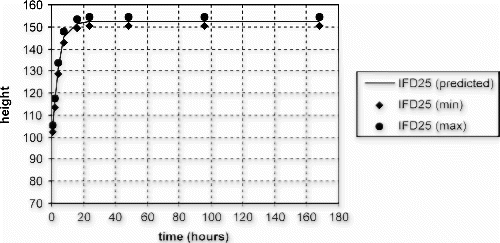Abstract
A randomized half-factorial design with one centerpoint was used to investigate the effect of five process factors on a critical attribute indentation force deflection (IFD) of a polyurethane foam vs. time, where time was employed as a blocking variable. The goal was to determine time-dependent models that would predict this characteristic with varying process conditions. Our results showed that IFD could be fit to a series of nonlinear models of the form:
Introduction
When flexible polyurethane foam is made—as in cushioning material for seating—certain of its characteristics change with time. Our study concerns the so-called indentation force deflection (IFD). This is a test of the foam's load-bearing capacity. Indentation force deflection is generally measured as the force required to compress a 50-in.2 circular indentor foot into a 4-in. thick sample, typically 15 in. square or larger, to a stated percentage of the sample's initial height. Common IFD values are generated at 25% and 65% of the initial height; these are termed IFD25 and IFD65, respectively.Footnotea Both IFD values eventually stabilize and approach asymptotic levels with increasing time due to the continuing, decelerating, chemical reaction that creates the foam. The asymptotic levels depend on the process conditions employed. It is important to note that up to 1 week may be required for the IFD values to reach their terminal equilibrium levels.
Conventional quality-assurance procedures usually require that IFD be measured the day the foam is produced. At the same time, it is necessary to accurately predict the asymptotic level at 168 hours (7 days). This is so because the asymptotic IFD value is a critical product specification. It is not feasible, however, to wait a week to measure the asymptotic level, since a large amount of product would have to be stored; doing so would negatively impact production rates. Because various process conditions are used, it was desirable to create a global model of IFD vs. time. The goal was to use the global model to predict asymptotic IFD values based on measurements shortly after the foam was produced.
Designed Experiment For Ifd
A randomized, half-factorial designed experiment (Table ) was employed to determine the effect of five process factors (x1–x5) on IFD25.Footnoteb This design can detect all main effects and all two-fold interactions. The addition of the centerpoint was included to allow the detection of error (Citation1). For each run condition, IFD25 was measured on three samples at 4, 8, 24, 48, 96, and 168 hours. The average IFD25 was then used to create a nonlinear model of IFD25 vs. time for each run. Typical IFD25 vs. time results are shown in Table .
Table 1. Randomized design used in this study
Table 2. Results of average IFD25 vs. time (run #11)
Models For Average Ifd
Models for the average IFD25 vs. time were determined by nonlinear regression analysis using Statgraphics® and Marquardt's coefficient estimation method (Citation2 Citation3 Citation4). In general, several iterations of the procedure were required to obtain convergence. The models were of the form:
A typical result of a fitted model is shown in Fig. . The nonlinear regression coefficients (β i ) for all runs are shown in Table .
Table 3. Nonlinear regression coefficients for average IFD25
Analysis Of Designed Experiment
After elimination of insignificant terms, we obtained the models shown in Table for the nonlinear regression coefficients as functions of the process variables, x1–x5.
Table 4. Models for nonlinear coefficients
Discussion
As mentioned in the introduction, the goal was to predict the asymptotic value of IFD25 with a given set of process conditions based on a measurement shortly after the parts were made. Note that the process factors, x1–x5, are continuous and can vary randomly between −1 and +1. Accordingly, we used the RANDBETWEEN() function in Excel to generate random numbers between −1 and +1 and the models in Table to generate results like those shown in Table and Fig. . Note that the predicted values—as well as the min/max values based on the β i standard errors—are given.
Table 5. Values of nonlinear coefficients using random values for x1–x5
Under these conditions, the predicted asymptotic IFD25 value at 168 hours is 152±2. Similarly, the predicted value at a shorter time, i.e., 4 hours, is 131±3.
Conclusions
The results of this exploratory study showed that it is feasible to model and predict the asymptotic IFD values of polyurethane foam based on measurements taken shortly after the parts are produced. This procedure is desirable because it allows production to proceed at its normal pace. Otherwise, parts would have to be stored for up to 1 week before quality-assurance measurements could be performed. A half-factorial experiment was used in this work. To improve the predictive capability of the model, further study is recommended employing three-level designs such as a central composite design.
Acknowledgments
Notes
bSimilar work was done for ILD65 but is not reported here.
aTest Method ASTM D3574.
References
- Bates , D. M. and Watts , D. G. 1988 . Nonlinear Regression Analysis and Its Applications New York : Wiley .
- Box , G. E. P. , Hunter , W. G. and Hunter , J. S. 1978 . Statistics for Experimenters New York : Wiley .
- Draper , N. R. and Smith , H. 1998 . Applied Regression Analysis , 3rd ed. New York : Wiley .
- Marquardt , D. W. 1963 . J. Soc. Ind. Appl. Math. , 11 : 431

